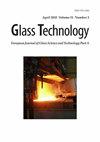含粉煤灰新型玻璃组合物的热学、光学和力学性能
IF 0.3
4区 材料科学
Q4 MATERIALS SCIENCE, CERAMICS
Glass Technology-European Journal of Glass Science and Technology Part a
Pub Date : 2021-01-01
DOI:10.13036/17533546.62.3.007
引用次数: 0
摘要
从典型的建筑工程应用,如铸块或浮法玻璃的形式,到更先进的技术,如3d打印玻璃或玻璃-金属连接,对新成分的研究对于扩展玻璃的可能应用至关重要。由于高熔融温度和脆性是玻璃的两个重要缺点,这项工作旨在改善这两种性能。表征技术,如热分析,纳米压痕和紫外/可见光谱,用于评估样品的性质。性能的改变是通过改变玻璃的组成来实现的,使用了五氧化二磷、氧化铝和氧化硼等化合物。然后,选择不同的玻璃形成剂和改性剂有助于开发具有较低熔融温度和玻璃化转变温度的组合物。熔化温度的降低可以在制造过程中节省能源。玻璃的结构不同于标准的钠石灰硅玻璃和硼硅酸盐玻璃,导致不同的机械行为。此外,这些新组合物的配方中含有高达35%的粉煤灰。这些副产品的增值降低了成本和气体排放。本文章由计算机程序翻译,如有差异,请以英文原文为准。
Thermal, optical and mechanical properties of new glass compositions containing fly ash
The investigation of new compositions is crucial for the expansion of possible applications of glass, from the typical applications for building engineering, in the form of cast blocks or float glass, to more advanced technologies, such as 3D-printed glass or glass-to-metal connections. Since high melting temperatures and brittleness are two important drawbacks of glass, this work aims to improve both properties. Characterisation techniques, such as thermal analysis, nano-indentation, and UV/VIS spectroscopy, are used to evaluate the properties of the samples. The modification of the properties is achieved via changes in the composition of the glass, using compounds such as phosphorus pentoxide, aluminium oxide and boron oxide. Then, the choice of different glass formers and modifiers contributes to the development of compositions with lower melting and glass transition temperatures. The reduction of the melting temperature allows a saving of energy during the manufacturing. The structures of the glasses differ from the standard soda–lime–silica and borosilicate glasses, leading to a different mechanical behaviour. Furthermore, these new compositions incorporate up to 35% of fly ash in their formulas. The valorisation of these by-products reduces costs and gas emission.
求助全文
通过发布文献求助,成功后即可免费获取论文全文。
去求助
来源期刊
CiteScore
0.30
自引率
0.00%
发文量
0
审稿时长
>12 weeks
期刊介绍:
The Journal of the Society of Glass Technology was published between 1917 and 1959. There were four or six issues per year depending on economic circumstances of the Society and the country. Each issue contains Proceedings, Transactions, Abstracts, News and Reviews, and Advertisements, all thesesections were numbered separately. The bound volumes collected these pages into separate sections, dropping the adverts. There is a list of Council members and Officers of the Society and earlier volumes also had lists of personal and company members.
JSGT was divided into Part A Glass Technology and Part B Physics and Chemistry of Glasses in 1960.

 求助内容:
求助内容: 应助结果提醒方式:
应助结果提醒方式:


